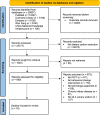Technology-supported behavior change interventions for reducing sodium intake in adults: a systematic review and meta-analysis
- PMID: 38499729
- PMCID: PMC10948864
- DOI: 10.1038/s41746-024-01067-y
Technology-supported behavior change interventions for reducing sodium intake in adults: a systematic review and meta-analysis
Abstract
The effects of technology-supported behavior change interventions for reducing sodium intake on health outcomes in adults are inconclusive. Effective intervention characteristics associated with sodium reduction have yet to be identified. A systematic review and meta-analysis were conducted, searching randomized controlled trials (RCTs) published between January 2000 and April 2023 across 5 databases (PROSPERO: CRD42022357905). Meta-analyses using random-effects models were performed on 24-h urinary sodium (24HUNa), systolic blood pressure (SBP), and diastolic blood pressure (DBP). Subgroup analysis and meta-regression of 24HUNa were performed to identify effective intervention characteristics. Eighteen RCTs involving 3505 participants (51.5% female, mean age 51.6 years) were included. Technology-supported behavior change interventions for reducing sodium intake significantly reduced 24HUNa (mean difference [MD] -0.39 gm/24 h, 95% confidence interval [CI] -0.50 to -0.27; I2 = 24%), SBP (MD -2.67 mmHg, 95% CI -4.06 to -1.29; I2 = 40%), and DBP (MD -1.39 mmHg, 95% CI -2.31 to -0.48; I2 = 31%), compared to control conditions. Interventions delivered more frequently (≤weekly) were associated with a significantly larger effect size in 24HUNa reduction compared to less frequent interventions (>weekly). Other intervention characteristics, such as intervention delivery via instant messaging and participant-family dyad involvement, were associated with larger, albeit non-significant, effect sizes in 24HUNa reduction when compared to other subgroups. Technology-supported behavior change interventions aimed at reducing sodium intake were effective in reducing 24HUNa, SBP, and DBP at post-intervention. Effective intervention characteristics identified in this review should be considered to develop sodium intake reduction interventions and tested in future trials, particularly for its long-term effects.
© 2024. The Author(s).
Conflict of interest statement
The authors declare no competing interests.
Figures




Similar articles
-
The impact of sprint interval training versus moderate intensity continuous training on blood pressure and cardiorespiratory health in adults: a systematic review and meta-analysis.PeerJ. 2024 Mar 14;12:e17064. doi: 10.7717/peerj.17064. eCollection 2024. PeerJ. 2024. PMID: 38495758 Free PMC article.
-
Effect of l-Arginine Supplementation on Blood Pressure in Adults: A Systematic Review and Dose-Response Meta-analysis of Randomized Clinical Trials.Adv Nutr. 2022 Aug 1;13(4):1226-1242. doi: 10.1093/advances/nmab155. Adv Nutr. 2022. PMID: 34967840 Free PMC article.
-
Study of low salt diet in hypertensive patients with chronic kidney disease.Med J Malaysia. 2018 Dec;73(6):376-381. Med J Malaysia. 2018. PMID: 30647207 Clinical Trial.
-
Efficacy of telemedicine on glycaemic control in patients with type 2 diabetes: A meta-analysis.World J Diabetes. 2021 Feb 15;12(2):170-197. doi: 10.4239/wjd.v12.i2.170. World J Diabetes. 2021. PMID: 33594336 Free PMC article.
-
The significance of duration and amount of sodium reduction intervention in normotensive and hypertensive individuals: a meta-analysis.Adv Nutr. 2015 Mar 13;6(2):169-77. doi: 10.3945/an.114.007708. Print 2015 Mar. Adv Nutr. 2015. PMID: 25770255 Free PMC article. Review.
Cited by
-
Blood pressure impact of dietary practices using the DASH method: a systematic review and meta-analysis.Clin Hypertens. 2025 Apr 1;31:e12. doi: 10.5646/ch.2025.31.e12. eCollection 2025. Clin Hypertens. 2025. PMID: 40201316 Free PMC article.
-
Dyadic Interventions for Promoting Healthy Diets in Patients With Cardiovascular Disease: A Systematic Review and Meta-Analysis.Nurs Health Sci. 2025 Sep;27(3):e70183. doi: 10.1111/nhs.70183. Nurs Health Sci. 2025. PMID: 40704437 Free PMC article. Review.
-
Towards 'Formalising' WhatsApp Teledermatology Practice in KZ-N District Hospitals: Key Informant Interviews.Int J Environ Res Public Health. 2024 Oct 21;21(10):1388. doi: 10.3390/ijerph21101388. Int J Environ Res Public Health. 2024. PMID: 39457361 Free PMC article.
-
Persistent effect of salt reduction in schoolchildren and their families: 1-year follow-up after an application-based cluster randomized controlled trial.BMC Med. 2025 Jan 27;23(1):41. doi: 10.1186/s12916-025-03868-8. BMC Med. 2025. PMID: 39865267 Free PMC article. Clinical Trial.
References
-
- World Health Organization. Guideline: Sodium Intake for Adults and Children. (World Health Organization, 2012). - PubMed
-
- World Health Organization. Salt Reductionhttps://www.who.int/news-room/fact-sheets/detail/salt-reduction (2020).
-
- Aliasgharzadeh S, Tabrizi JS, Nikniaz L, Ebrahimi-Mameghani M, Lotfi Yagin N. Effect of salt reduction interventions in lowering blood pressure: a comprehensive systematic review and meta-analysis of controlled clinical trials. PLoS ONE. 2022;17:e0277929. doi: 10.1371/journal.pone.0277929. - DOI - PMC - PubMed
Publication types
LinkOut - more resources
Full Text Sources
Miscellaneous

